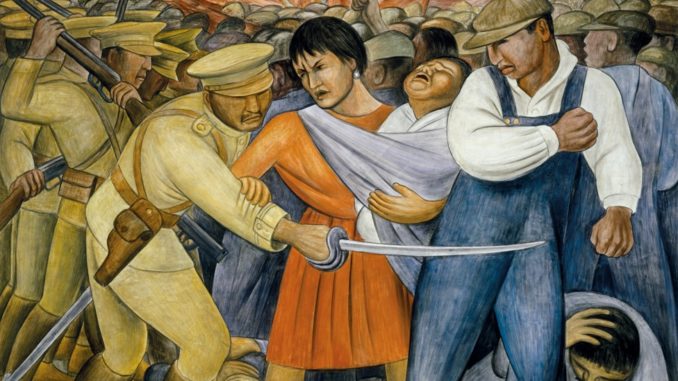by IMMANUEL WALLERSTEIN
 The Uprising, by Diego Rivera, 1931
The Uprising, by Diego Rivera, 1931
The period 1945 to the 1970s was one both of extremely high capital accumulation worldwide and the geopolitical hegemony of the United States. The geoculture was one in which centrist liberalism was at its acme as the governing ideology. Never did capitalism seem to be functioning as well. This was not to last.
The high level of capital accumulation, which particularly favored the institutions and people of the United States, reached the limits of its ability to guarantee the necessary quasi-monopoly of productive enterprises. The absence of a quasi-monopoly meant that capital accumulation everywhere began to stagnate and capitalists had to seek alternative modes of sustaining their income. The principal modes were to relocate productive enterprises to lower-cost zones and to engage in speculative transfer of existing capital, which we call financialization.
In 1945, the geopolitical quasi-monopoly of the United States was faced only with the challenge of the military power of the Soviet Union. In order to ensure its quasi-monopoly, the United States had to enter into a tacit but effective deal with the Soviet Union, nicknamed “Yalta.” This deal involved a division of world power, two-thirds to the United States and one-third to the Soviet Union. They mutually agreed not to challenge these boundaries, and not to interfere with each other’s economic operations within their sphere. They also entered into a “cold war,” whose function was not to overthrow the other (at least in a foreseeable future) but to maintain the unquestioned loyalty of their respective satellites. This quasi-monopoly also came to an end because of the growing challenge to its legitimacy from those who lost out by the status quo.
In addition, this period was also one in which the traditional antisystemic movements called the Old Left – Communists, Social-Democrats, and National Liberation Movements – came to state power in various regions of the world-system, something that had seemed highly improbable as late as 1945. One-third of the world was governed by Communist parties. One-third was governed by Social-Democratic parties (or their equivalent) in the pan-European zone (North America, western Europe, and Australasia). In this zone, power alternated between Social-Democratic parties that embraced the welfare state, and Conservative parties that also accepted the welfare state, only seeking to reduce its extent.
And in the last region, the so-called Third World, national liberation movements come to power by winning independence in most of Asia, Africa, and the Caribbean, and promoting popular regimes in already independent Latin America.
Given the strength of the dominant powers and especially the United States, it might seem anomalous that antisystemic movements came to power in this period. In fact, it was the opposite. In seeking to resist the revolutionary impact of anti-colonial and anti-imperialist movements, the United States favored concessions with the hope and expectation that they would bring to power “moderate” forces in these countries that would be willing to operate within accepted norms of interstate behavior. This expectation turned out to be correct.
The turning point was the world-revolution of 1968, whose dramatic if short-lived upsurge of 1966-1970 had two major results. One was the end of the very long dominance of centrist liberalism (1848-1968) as the only legitimate ideology in the geoculture. Instead, both radical leftist ideology and rightist conservative ideology regained their autonomy and centrist liberalism was reduced to being only one of three competing ideologies.
Toward Freedom for more
